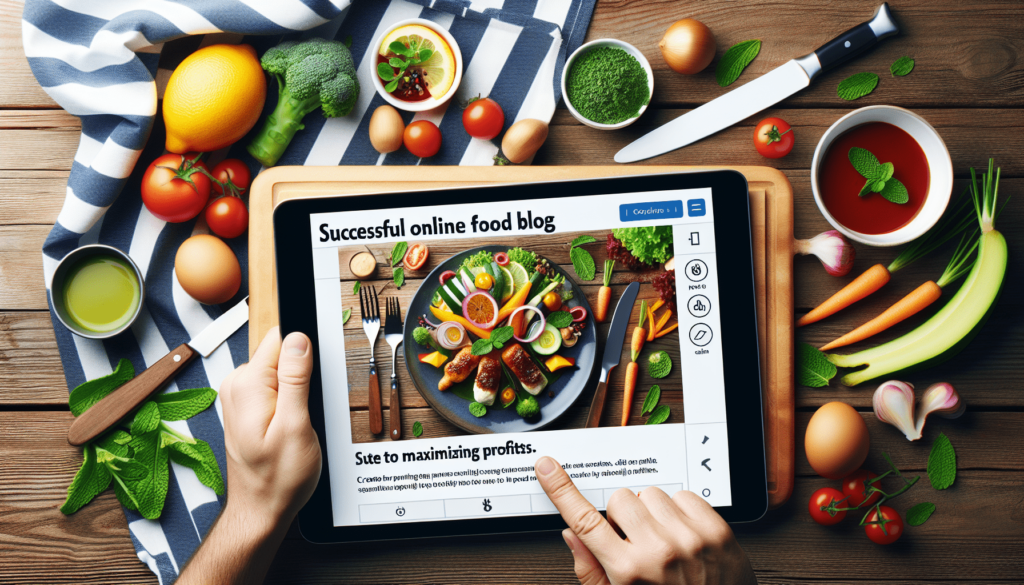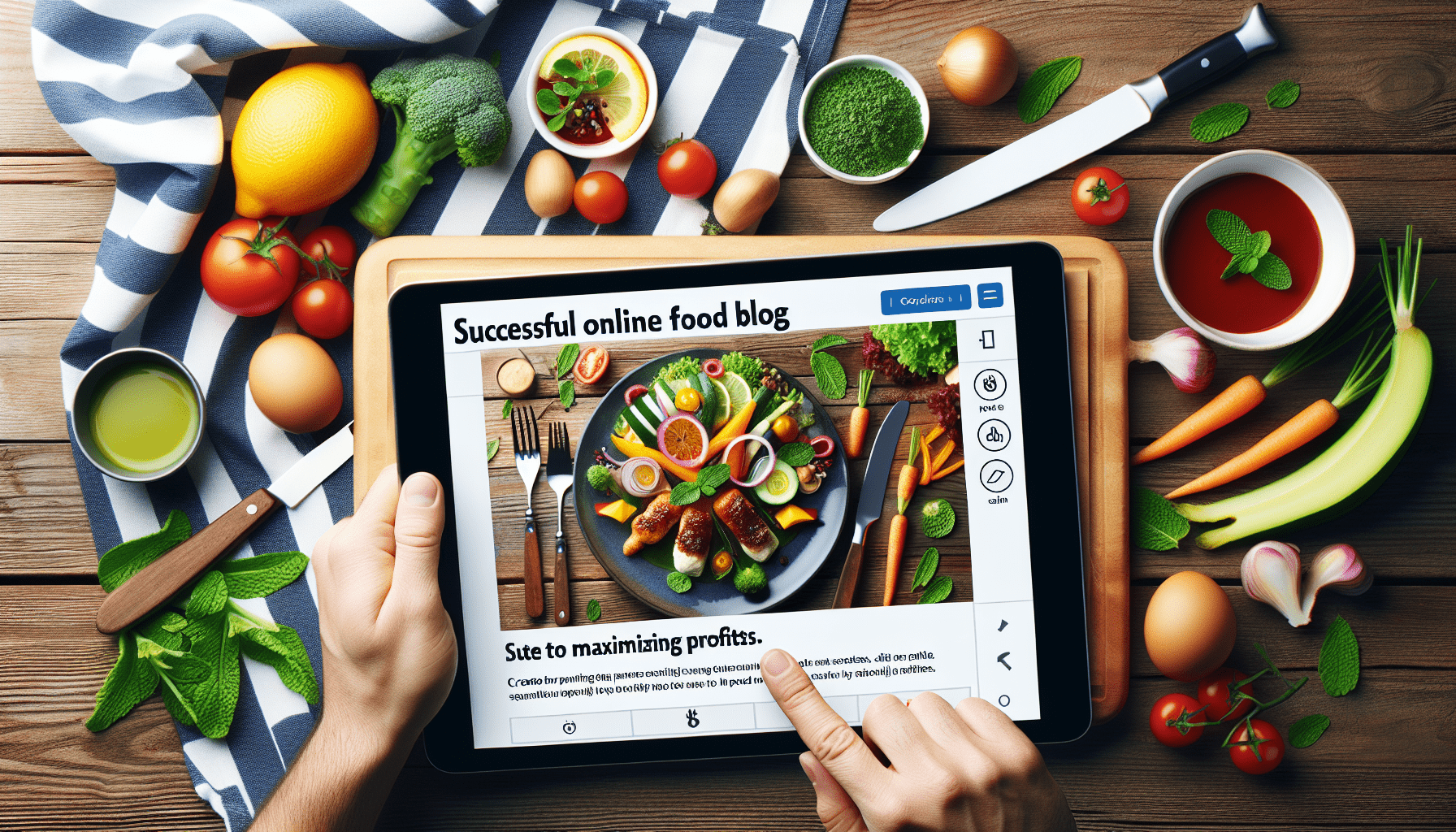In today's digital age, finding innovative ways to connect with audiences and capitalize on opportunities is essential for maximizing profits. Enter BackersHub.com, a platform where possibilities meet profitability. If you have an online food blog and are looking for strategies that work best for monetizing your passion, look no further. This article will explore proven techniques and insights to help you turn your love for food into a successful and lucrative online business. Get ready to tantalize taste buds and boost your bank account!

Unlock Earning Power: My $7 Mega Link Secret Revealed!
Creating High-Quality Content
Developing Original Recipes
When it comes to creating a successful food blog, developing original recipes is key. Your audience is constantly on the lookout for fresh and unique ideas, and by providing them with innovative recipes, you can set yourself apart from the competition. Experiment with different flavor combinations, ingredients, and cooking techniques to create exciting dishes that will keep your readers coming back for more. Don't be afraid to think outside the box and put your own spin on traditional recipes. Your creativity and passion for food will shine through in your original recipes.
Taking High-Quality Food Photos
In the world of food blogging, high-quality food photos are essential. Captivating visuals can instantly grab the attention of your audience and entice them to try your recipes. Invest in a good camera and learn some basic photography techniques to ensure that your food photos are clear, well-lit, and visually appealing. Pay attention to styling and composition, using props and garnishes to enhance the overall look of your dishes. Remember, a mouthwatering photo can make all the difference in attracting readers to your blog.
Writing Engaging and Informative Blog Posts
In addition to amazing recipes and stunning photos, engaging and informative blog posts are crucial for building a loyal readership. Share the story behind your recipe, highlighting any unique ingredients or techniques you used. Provide tips, tricks, and step-by-step instructions to make it easy for your audience to replicate your dishes at home. Don't forget to inject your own personality into your writing, making your posts relatable and enjoyable to read. Engaging with your audience through comments and social media is also important, as it fosters a sense of community and encourages interaction.
Building a Strong Brand
Defining Your Brand Identity
To create a successful food blog, it's important to have a clear brand identity. Define what sets you apart from other bloggers and identify your target audience. Consider the style of cuisine you specialize in, your cooking philosophy, and the overall theme and tone of your blog. This will help you establish a unique brand that resonates with your readers and attracts new followers. Remember to stay true to your brand identity in all aspects of your blogging, from the recipes you create to the way you interact with your audience.
Creating a Memorable Logo and Website Design
A visually appealing logo and website design are vital for building a strong brand. Your logo should be simple, memorable, and evoke the essence of your blog. Consider working with a professional designer to create a logo that reflects your brand identity. When it comes to your website design, choose a layout that is clean, easy to navigate, and showcases your content effectively. Use colors, fonts, and images that align with your brand identity and create a cohesive visual experience for your readers.
Consistent Branding Across Social Media Platforms
Consistency is key when it comes to building a strong brand. Ensure that your brand identity is consistent across all your social media platforms, including Instagram, Facebook, and Twitter. Use the same logo, color palette, and tone of voice to create a cohesive brand experience for your audience. Engage with your followers regularly, responding to comments and messages in a timely manner. By maintaining a consistent and engaging presence on social media, you can strengthen your brand and build a loyal community of followers.
Life-Changing: How a Simple Link Brought Me Financial Freedom!
Utilizing Search Engine Optimization (SEO)
Performing Keyword Research
To increase your blog's visibility and reach a wider audience, it's important to perform keyword research. Identify the keywords and phrases that are relevant to your niche and incorporate them into your blog posts. Use tools like Google Keyword Planner or SEMrush to find popular and high-ranking keywords in your industry. By optimizing your content with targeted keywords, you can improve your blog's search engine rankings and attract organic traffic to your site.
Optimizing Blog Posts for SEO
In addition to incorporating keywords, there are several other SEO techniques you can utilize to optimize your blog posts. Use descriptive and keyword-rich titles for your posts, as well as headings and subheadings that clearly communicate the content of each section. Include relevant meta tags, such as meta descriptions and alt tags for your images. Optimize your URL structure and ensure that your blog is mobile-friendly. By implementing these SEO strategies, you can improve your blog's visibility and attract more readers.
Building Backlinks and Increasing Domain Authority
Building backlinks, or links from other websites to your blog, is an effective way to increase your blog's domain authority and improve its search engine rankings. Reach out to other bloggers and websites in your niche and ask if they would be interested in featuring your content or collaborating on a guest post. Participate in online communities, such as forums or Facebook groups, and share your expertise by providing valuable insights and resources. By building relationships and earning backlinks from reputable sources, you can establish your blog as a trusted authority in the food blogging community.
Leveraging Social Media Platforms
Creating a Social Media Marketing Strategy
Social media platforms provide a valuable opportunity to connect with your audience and promote your blog. Develop a social media marketing strategy that aligns with your brand identity and goals. Identify the platforms that your target audience is most active on and create engaging content specifically tailored to each platform. Utilize features like hashtags, geotagging, and stories to increase visibility and engagement. Consistency is key, so make sure to schedule regular posts and interact with your followers to build a strong online presence.
Engaging with Your Audience on Social Media
Engagement is not just about posting content; it's also about interacting with your audience. Respond to comments, direct messages, and mentions in a timely and friendly manner. Ask questions, run polls, and encourage your followers to share their thoughts and experiences. Show genuine interest in their feedback and incorporate their suggestions into your blog and social media content when appropriate. By fostering a sense of community and engaging with your audience, you can build a loyal following and generate high levels of social media growth.
Collaborating with Influencers and Brands
Collaborating with influencers and brands can help amplify your blog's reach and expose your content to a wider audience. Identify influencers and brands in your niche that align with your brand identity and values. Reach out to them with a personalized pitch, highlighting the unique value you can offer through a collaboration. This could include guest blogging, recipe exchanges, or social media takeovers. By partnering with influencers and brands, you can tap into their existing audience and build valuable relationships within the food blogging community.

Daily Payday From Your Couch? Try now for the cost of a cup of coffee!
Monetizing Your Blog with Advertisements
Applying for Ad Networks
One popular way to monetize your food blog is by applying for ad networks. Ad networks, such as Google AdSense or Mediavine, allow you to display ads on your blog and earn revenue based on the number of impressions or clicks the ads receive. Research different ad networks and their requirements, and apply to those that align with your blog's niche and audience. Once approved, you can start displaying ads on your blog and earn a passive income.
Placing Ads Strategically on Your Blog
The placement of ads on your blog plays a significant role in their effectiveness. Strategically place ads in areas where they are most likely to be noticed, such as the sidebar, header, or within the content itself. However, be mindful not to overwhelm your readers with too many ads, as this can detract from the overall user experience of your blog. Experiment with different ad placements and analyze their performance to optimize your revenue.
Optimizing Ad Revenue with A/B Testing
To maximize your ad revenue, consider conducting A/B testing. This involves comparing two versions of a web page, each with a different ad layout, to determine which one generates higher earnings or better user engagement. Test different ad formats, sizes, and placements to find the optimal combination that balances revenue generation with a positive user experience.
Generating Income through Sponsored Content
Collaborating with Brands for Sponsored Posts
Sponsored posts offer a great opportunity to generate income while showcasing products or services that align with your brand. Collaborate with brands that resonate with your blog's niche and audience. Reach out to them or create a media kit to pitch your value as an influencer and the benefits of partnering with you. Craft engaging and authentic sponsored content that incorporates the brand's message while maintaining your unique voice and style. Make sure to comply with the applicable disclosure guidelines to maintain transparency with your audience.
Negotiating Fair Compensation
When engaging in sponsored partnerships, it's essential to negotiate fair compensation for your work. Consider factors such as the reach and engagement of your blog, the time and effort required to create the content, and the exclusivity of the partnership. Research industry standards and reach out to other bloggers in your niche for guidance on fair rates. Remember, your time and expertise hold value, so don't be afraid to advocate for appropriate compensation.
Maintaining Authenticity and Transparency
Maintaining authenticity and transparency is vital when creating sponsored content. Only collaborate with brands and products that you genuinely believe in and that align with your brand's values. Disclose any sponsorships or partnerships clearly and prominently, whether it's in the blog post itself, social media captions, or video descriptions. Building trust with your audience is crucial, and being open and honest about sponsored content helps maintain that trust.
Shocking! This one link can pay you time and time again!
Creating and Selling Digital Products
Developing E-books or Cookbooks
Developing and selling e-books or cookbooks is an excellent way to monetize your food blog while providing valuable content to your audience. Compile your original recipes, along with beautiful food photos and engaging content, into a well-designed e-book or cookbook. Promote your digital products on your blog and social media platforms, offering discounts or bonus content to incentivize purchases. Online marketplaces like Amazon Kindle or your own e-commerce store can serve as platforms for selling your digital products.
Creating Online Courses or Tutorials
If you have specialized knowledge or skills, consider creating online courses or tutorials to generate income from your food blog. Share your expertise in cooking techniques, recipe development, or specific cuisines through comprehensive video or written lessons. Platforms like Teachable or Udemy can help you create and sell your online courses easily. Market these courses on your blog, social media, and through email marketing to leverage your existing audience and attract new students.
Setting Up an E-commerce Store on Your Blog
Setting up an e-commerce store on your blog allows you to sell a variety of products related to your niche. Consider offering merchandise like aprons, kitchen gadgets, or specialty ingredients that are relevant to your brand. Use an e-commerce platform like Shopify or WooCommerce to create a seamless shopping experience for your audience. Integrate your store with your blog and social media channels to increase visibility and drive sales.
Implementing Affiliate Marketing Strategies
Joining Affiliate Programs
Affiliate marketing involves promoting products or services and earning a commission for each sale or referral made through your unique affiliate link. Join affiliate programs offered by companies that align with your blog's niche and audience. Research and recommend products that you genuinely believe in and have personally used. Amazon Associates, ShareASale, and CJ Affiliate are popular affiliate networks to consider. Remember to disclose your affiliate relationships transparently to maintain trust with your readers.
Writing Honest and Convincing Product Reviews
Writing honest and convincing product reviews is a powerful way to generate affiliate income. Test products thoroughly and provide detailed, unbiased reviews that highlight their features, benefits, and potential drawbacks. Be transparent about your affiliate relationships, disclosing that you may earn a commission from purchases made through your affiliate links. Focus on products that genuinely add value to your audience, as promoting low-quality or irrelevant products can damage your reputation.
Using Affiliate Links Strategically
Strategic placement of affiliate links can significantly impact your affiliate marketing success. Incorporate affiliate links naturally within your blog posts, linking relevant keywords or phrases to the products or services you are promoting. Use eye-catching call-to-action buttons or banners to attract clicks and encourage readers to make a purchase. Experiment with different placement strategies and analyze your affiliate marketing analytics to optimize your conversion rates and earnings.
Unlock Earning Power: My $7 Mega Link Secret Revealed!
Offering Personalized Services and Consultations
Providing Recipe Development Services
If you have a knack for creating innovative recipes, consider offering recipe development services to other bloggers, brands, or publications. Share your expertise, creativity, and unique perspective to help others develop new and exciting dishes. Collaborate with clients to develop customized recipes tailored to their specific needs and target audience. Promote your services on your blog, social media, and professional networking platforms to attract potential clients.
Offering Cooking or Baking Classes
Sharing your culinary skills through cooking or baking classes is a fantastic way to generate income while connecting with your audience on a deeper level. Consider offering in-person or virtual classes where you can teach your favorite recipes, cooking techniques, or culinary tips. Create a structured curriculum, provide clear instructions, and offer hands-on guidance to ensure a valuable learning experience for your students. Promote your classes through your blog, social media, and local community networks.
Providing Menu Planning and Meal Prep Services
Many individuals struggle with meal planning and meal prep, opening up an opportunity for you to provide personalized services in this area. Offer menu planning and meal prep packages, helping your clients save time and stress in their daily lives. Develop customized meal plans based on their dietary preferences, restrictions, and health goals. Provide detailed shopping lists, step-by-step instructions, and tips for efficient meal prepping. Promote your services as a convenient and time-saving solution for busy individuals or families.
Building and Engaging with an Email List
Creating Valuable Lead Magnets
A lead magnet is a valuable free resource that you offer to your audience in exchange for their email address. Create lead magnets such as e-books, meal plans, or exclusive recipes that provide high value to your readers. Promote these lead magnets on your blog and social media, enticing your audience to subscribe to your email list. Ensure that your lead magnets align with your blog's niche and offer practical solutions or inspiration that your target audience is seeking.
Designing Eye-Catching Opt-in Forms
Opt-in forms are the gateway to growing your email list. Design eye-catching and user-friendly opt-in forms that entice your readers to subscribe. Place opt-in forms strategically on your blog, such as in your sidebar, at the end of blog posts, or as pop-ups. Experiment with different form designs, headlines, and call-to-action buttons to optimize your conversion rates. Remember to clearly communicate the benefits of subscribing, whether it's access to exclusive content, discounts, or personalized updates.
Sending Regular Newsletters and Exclusive Content
Regularly sending newsletters to your email list is a powerful way to engage with your audience and drive traffic to your blog. Share exclusive content, behind-the-scenes glimpses, or personalized updates to provide added value to your subscribers. Craft compelling subject lines and preview texts to entice your readers to open and read your newsletters. Include links to your latest blog posts, collaborations, or offers to drive traffic and encourage further engagement. Personalize your newsletters as much as possible to make your subscribers feel valued and appreciated.
In conclusion, creating a successful online food blog requires the creation of high-quality content, building a strong brand, implementing effective SEO strategies, leveraging social media platforms, monetizing through advertisements and sponsored content, creating and selling digital products, utilizing affiliate marketing strategies, offering personalized services, and building and engaging with an email list. By following these comprehensive strategies, you can maximize your profits and create a thriving online food blogging business.
Life-Changing: How a Simple Link Brought Me Financial Freedom!

